A heroic game by Vladimir Kramnik and Deep Fritz
Instead of playing for a small advantage, Vladimir Kramnik played a stunning
piece sacrifice on move 19 for a deadly attack on Fritz's king. The computer
played flawless defense and Kramnik's attack slowly dried up. With just minutes
on his clock Kramnik's position quickly fell apart against Fritz's counterattack
and he resigned on move 34. A truly spectacular game that will require many
days of man-machine analysis to understand completely.

Alex Kure with his notebook containg the Fritz opening preparation
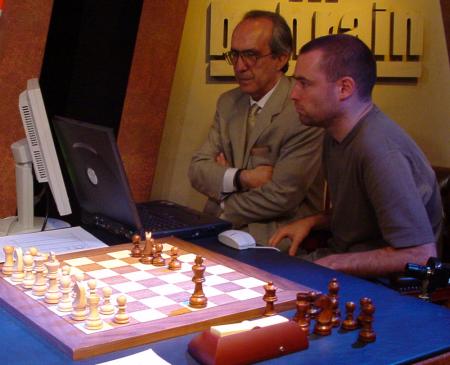
Before the game Alex is allowed to tell Fritz which lines to play, under
the
watchful eyes of the arbiter Enrique Irazoqui.
Before the game the Fritz team insisted that it wouldn't be easy for Kramnik
to draw against the super-program. "We are going to go down fighting,"
said Frederic Friedel, "he'll be nervous after game five and we'll keep
the pressure on him." Anyone betting on the result of this game could have
earned 7 to 1 by putting their money on Fritz!
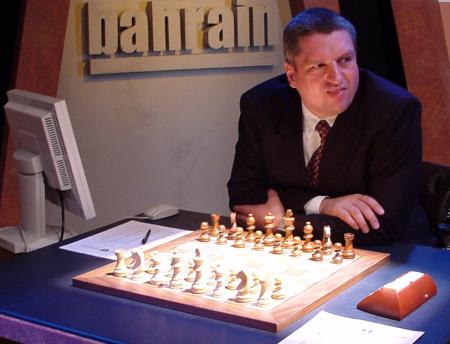
Mathias Feist of the Fritz team waiting for the champ to arrive
That would have been money well invested as Fritz got the best opening it
had seen during the match. Not that it liked its position, but it was a very
complicated one with most of the pieces still on the board. Kramnik went into
a 42-minute think on move 17, his longest contemplation of the match. He came
back to the board and unleashed the tremendous 19.Nxf7, sacrificing a full piece
to force the black king out into the open.
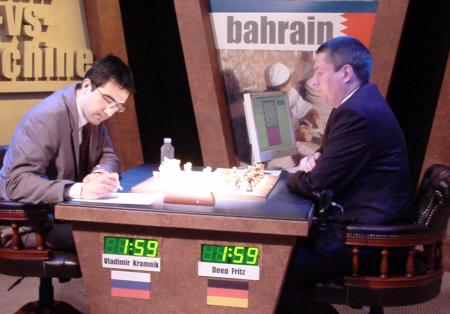
Start of game six, with Vladimir Kramnik facing Mathias Feist
It was brilliant, and perhaps a little foolhardy at the same time. This is
how Grandmasters often lose to computers. They get great attacking positions
that just too complex to play against a program like Fritz that is seeing three
million positions per second and can defend perfectly. You only need to miss
one key move to go down in flames, and today that's just what happened to the
world champion.

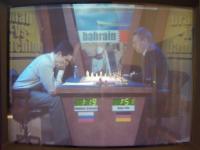

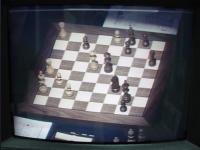


The game on the monitors around the playing site
Just as he was closing in for the kill Kramnik noticed what Fritz had seen
many moves earlier, a defensive move that looked like a typographical error
and that only a computer would find. Kramnik had planned 27.Qe6+ Nf6 28.f4,
winning. What he missed was 28...Bh4!!, the only move that doesn't lose instantly
and in fact, it wins the game for Black! Although he saw it in time, Kramnik
was stunned by this discovery and was now facing a losing position with just
15 minutes on his clock.

The position in which Kramnik played 19.Nxf7!!? The game
continued 19...Kxf7 20.Bd5+ Kg6 21.Qg4+ Bg5 22.Be4+ Rxe4 23.Qxe4+ Kh6 24.h4
Bf6 25.Bd2+ g5 26.hxg5+ Bxg5 27.Qh4+ Kg6 28.Qe4+ Kg7 29.Bxg5 Qxg5 30.Rfe1 cxb3
31.Qxd4+ Nf6 32.a5 Qd5 33.Qxd5 Nxd5 34.axb6 axb6 1-0.
Fritz mopped up quickly after that, gaining a passed b-pawn and swapping the
queens to remove any hope Kramnik may have had of saving the game. Ironic to
see Fritz eager to get the ladies off the board and Kramnik desperate to keep
them on! Fritz ended with a flourish, offering its bishop for a chance to play
b2 and Rc1. Instead, Kramnik resigned for the second game in a row.

Fritz author Frans Morsch with Vladimir Kramnik after the game
After the game the world champion said he had been unable to resist the beauty
of the piece sacrifice. "It had the potential to be the best game I have
ever played in my life." As it turned out, Kramnik gets the credit for
a spectacular game and a wonderful effort, but Fritz gets the point. Kramnik
was energized in the press conference after such a titanic struggle. "I'm
not depressed. When you play such a wonderful game you can't be. It could have
gone either way. Fritz played such great defense. I think I can still win the
match."

Alex Kure, GM Julian Hodgson and GM Daniel King analysing the game
Replay
the game with extensive analysis here.
Note that you can click on the notation to follow the moves




































